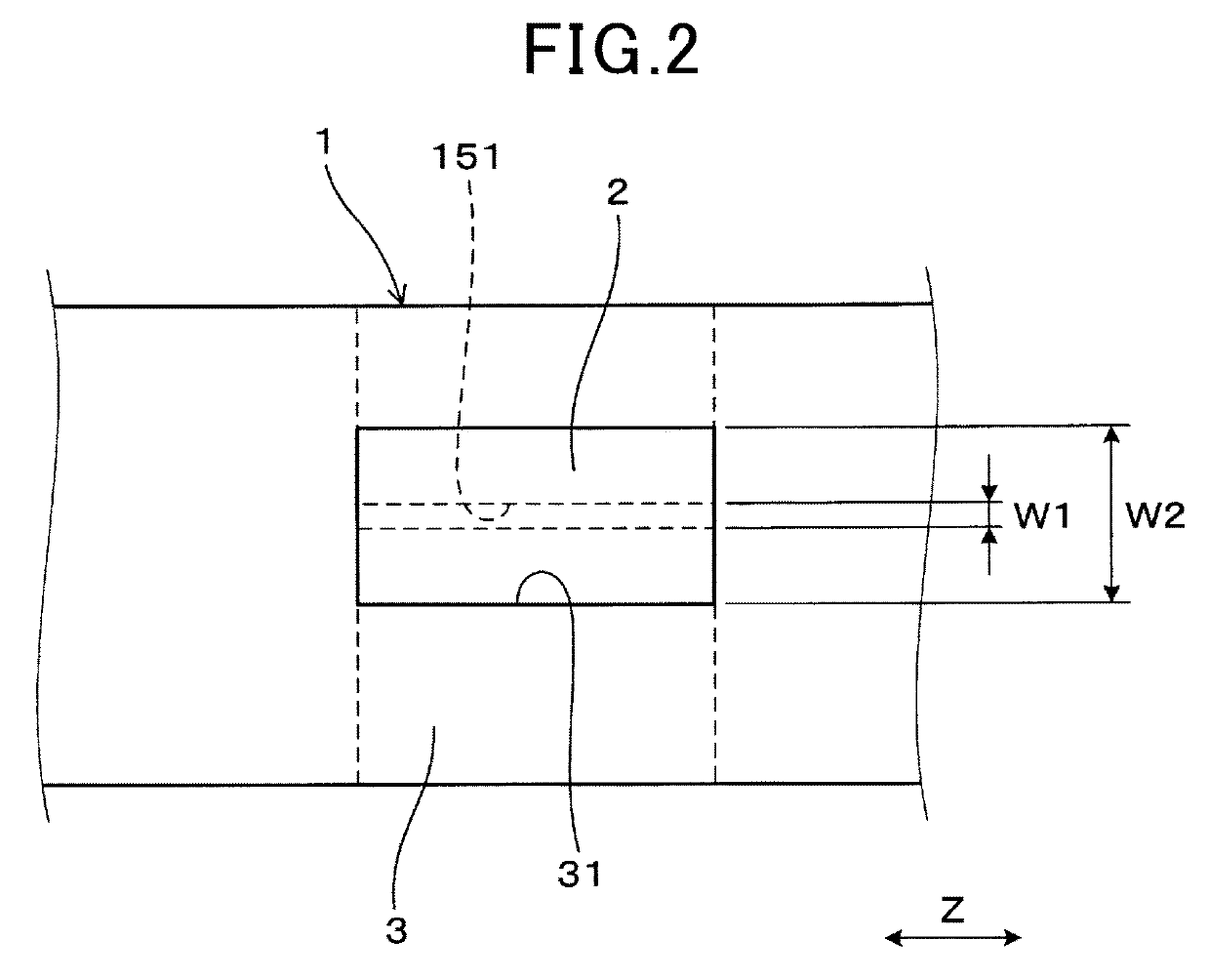Gas sensor element
a technology of gas sensor element and sensor element, which is applied in the field of gas sensor element, can solve the problems of reducing the waterproofness of the protective layer, unable to keep the surface roughness ra of the protective layer below or equal to 3.0 m, and disabling the protective layer from being water-repellent at high temperature, so as to improve the resistance of the gas sensor element to water damage and the resistance and suppress the damage of the gas sensor elemen
- Summary
- Abstract
- Description
- Claims
- Application Information
AI Technical Summary
Benefits of technology
Problems solved by technology
Method used
Image
Examples
first embodiment
(First Embodiment)
[0030]A gas sensor element 1 according to the first embodiment will be described hereinafter with reference to FIGS. 1-3.
[0031]As shown in FIG. 1, the gas sensor element 1 includes a main body 10, a trap layer 2 covering an outer peripheral surface 152 of the main body 10, and a protective layer 3 covering an outer peripheral surface of the trap layer 2.
[0032]The main body 10 includes a solid electrolyte body 11 having oxygen ion conductivity, a measurement gas-side electrode 12 provided on one surface of the solid electrolyte body 11, a reference gas-side electrode 13 provided on the other surface of the solid electrolyte body 11, and a porous diffusion-resistant layer 14 that allows a measurement gas G, which is introduced to the measurement gas-side electrode 12, to permeate therethrough.
[0033]The trap layer 2 is formed of a porous material that allows the measurement gas G to permeate therethrough. The trap layer 2 is provided to trap poisoning substances conta...
second embodiment
(Second Embodiment)
[0063]In the present embodiment, as shown in FIG. 4, the formation positions of the pair of measurement gas introduction ports 31 of the protective layer 3 in the gas sensor element 1 of the first embodiment are modified. Specifically, in the present embodiment, the measurement gas introduction ports 31 of the protective layer 3 are formed at positions distant from the main body-side introduction ports 151 of the gas introduction passage 15. More specifically, the measurement gas introduction ports 31 are formed at positions respectively opposite to those corners of the main body 10 where no main body-side introduction ports 151 are formed.
[0064]In the present embodiment, other configurations and contents indicated by reference signs in the drawings are the same as in the first embodiment.
[0065]In the gas sensor element 1 according to the present embodiment, the distances from the measurement gas introduction ports 31 to the main body-side introduction ports 151 a...
third embodiment
(Third Embodiment)
[0068]In the present embodiment, as shown in FIG. 5, the formation manner of the pair of measurement gas introduction ports 31 of the protective layer 3 in the gas sensor element 1 of the first embodiment is modified. Specifically, in the present embodiment, each of the measurement gas introduction ports 31 of the protective layer 3 is formed of a number of through-holes of ϕ0.01 mm-ϕ1.5 mm. Moreover, the formation position of each of the measurement gas introduction ports 31 of the protective layer 3 is a position opposite to one of the main body-side introduction ports 151 as in the first embodiment. In addition, the formation position of each of the measurement gas introduction ports 31, which is formed of a number of through-holes, may also be set to various positions opposite to neither of the main body-side introduction ports 151.
[0069]In the present embodiment, other configurations and contents indicated by reference signs in the drawings are the same as in ...
PUM
| Property | Measurement | Unit |
|---|---|---|
| porosity | aaaaa | aaaaa |
| temperature | aaaaa | aaaaa |
| surface roughness Ra | aaaaa | aaaaa |
Abstract
Description
Claims
Application Information
 Login to View More
Login to View More - R&D
- Intellectual Property
- Life Sciences
- Materials
- Tech Scout
- Unparalleled Data Quality
- Higher Quality Content
- 60% Fewer Hallucinations
Browse by: Latest US Patents, China's latest patents, Technical Efficacy Thesaurus, Application Domain, Technology Topic, Popular Technical Reports.
© 2025 PatSnap. All rights reserved.Legal|Privacy policy|Modern Slavery Act Transparency Statement|Sitemap|About US| Contact US: help@patsnap.com



